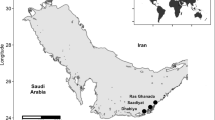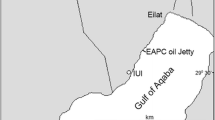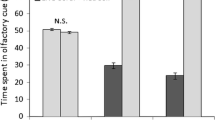Abstract
Rising atmospheric carbon dioxide (CO2) concentrations are causing additional CO2 to be absorbed by the oceans. Recent studies show that exposure to elevated CO2 causes olfactory impairment in reef fishes; however, the ecological consequences of this impairment are largely unknown. This study examined the effects of short-term exposure to elevated CO2 on habitat preferences of coral-dwelling gobies. Adult gobies collected from the reef at Lizard Island (Great Barrier Reef, Australia) were exposed for 4 days to ambient CO2 (440 μatm) or elevated CO2 (880 μatm). Habitat preferences were then tested in laboratory and field experiments at ambient conditions. In olfactory preference tests, Paragobiodon xanthosomus displayed a strong preference for odour cues of their sole host coral Seriatopora hystrix; however, this preference was absent in gobies exposed to elevated CO2. Habitat choice experiments conducted in the field showed that Gobiodon histrio placed on dead coral colonies located preferred live habitat within 24 h; however, gobies exposed to elevated CO2 associated with both preferred and non-preferred habitats in approximately equal frequency. Preferred habitats are known to confer fitness advantages to coral-dwelling gobies. Consequently, these results suggest that future elevated CO2 levels might affect the ability of habitat specialist fishes to select favourable habitats.


Similar content being viewed by others
References
Bates NR, Samuels L (2001) Biogeochemical and physical factors influencing seawater fCO2 and air-sea CO2 exchange on the Bermuda coral reef. Limnol Oceanogr 46:833–846
Bell JD, Galzin R (1984) Influence of live coral cover on coral-reef fish communities. Mar Ecol Progr Ser 15:265–274
Bellwood DR, Hoey AS, Ackerman JL, Depczynski M (2006) Coral bleaching, reef fish community phase shifts and the resilience of coral reefs. Global Change Biol 12:1587–1594
Bonin MC, Munday PL, McCormick MI, Srinivasan M, Jones GP (2009) Coral-dwelling fishes resistant to bleaching but not to mortality of host corals. Mar Ecol Progr Ser 394:215–222
Brooker RM, Munday PL, Ainsworth TD (2010) Diets of coral-dwelling fishes of the genus Gobiodon with evidence of corallivory. J Fish Biol 76:2578–2583
Caley MJ, Munday PL (2003) Growth trades off with habitat specialization. Proc R Soc B 270:175–177
Chabanet P, Ralambondrainy H, Amanieu M, Faure G, Galzin R (1997) Relationships between coral reef substrata and fish. Coral Reefs 16:93–102
Clarke RD (1992) Effects of microhabitat and metabolic rate on food intake, growth and fecundity of two competing coral fishes. Coral Reefs 11:119–205
Coker DJ, Pratchett MS, Munday PL (2009) Coral bleaching and habitat degradation increase susceptibility to predation for coral-dwelling fishes. Behav Ecol 20:1204–1210
Depczynski M, Bellwood DR (2006) Extremes, plasticity, and invariance in vertebrate life history traits: insights from coral reef fishes. Ecology 87:3119–3127
Devine BM, Munday PL, Jones GP (2012a) Rising CO2 concentrations affect settlement behaviour of larval damselfishes. Coral Reefs 31:229–238
Devine BM, Munday PL, Jones GP (2012b) Homing ability of adult cardinalfish is affected by elevated carbon dioxide. Oecologia 168:269–276
Dickson AG, Millero FJ (1987) A comparison of the equilibrium constants for the dissociation of carbonic acid in seawater media. Deep-Sea Res Part A 34:1733–1743
Dirnwöber M, Herler J (2007) Microhabitat specialisation and ecological consequences for coral gobies of the genus Gobiodon in the Gulf of Aqaba, northern Red Sea. Mar Ecol Progr Ser 342:265–275
Dixson DL, Munday PL, Jones GP (2010) Ocean acidification disrupts the innate ability of fish to detect predator olfactory cues. Ecol Lett 13:68–75
Domenici P, Allan B, McCormick M, Munday P (2012) Elevated carbon dioxide affects behavioural lateralization in a coral reef fish. Biol Lett 8:78–81
Doney SC, Fabry VJ, Feely RA, Kleypas JA (2009) Ocean acidification: the other CO2 problem. Ann Rev Mar Sci 1:169–192
Donner SD, Skirving WJ, Little CM, Oppenheimer M, Hoegh-Guldberg O (2005) Global assessment of coral bleaching and required rates of adaptation under climate change. Global Change Biol 11:2251–2265
Elliott JK, Mariscal RN (2001) Coexistence of nine anemonefish species: differential host and habitat utilization, size and recruitment. Mar Biol 138:23–26
Feary DA (2007) The influence of resource specialization on the response of reef fish to coral disturbance. Mar Biol 153:153–161
Ferrari MCO, Dixson DL, Munday PL, McCormick MI, Meekan MG, Sih A, Chivers DP (2011) Intrageneric variation in antipredator responses of coral reef fishes affected by ocean acidification: implications for climate change projections on marine communities. Global Change Biol 17:2980–2986
Friedlander AM, Parrish JD (1998) Habitat characteristics affecting fish assemblages on a Hawaiian coral reef. J Exp Mar Biol Ecol 224:1–30
Glynn PW (1993) Coral reef bleaching: ecological perspectives. Coral Reefs 12:1–17
Herler J (2007) Microhabitats and ecomorphology of coral- and coral rock-associated gobiid fish (Teleostei: Gobiidae) in the northern Red Sea. Mar Ecol 28:82–94
Hernaman V, Munday PL (2005) Life history characteristics of coral reef gobies I. Growth and lifespan. Mar Ecol Progr Ser 290:207–221
Hobbs J-PA, Munday PL (2004) Intraspecific competition controls spatial distribution and social organisation of the coral-dwelling goby Gobiodon histrio. Mar Ecol Progr Ser 278:253–259
Hoegh-Guldberg O (1999) Climate change, coral bleaching and the future of the world’s coral reefs. Mar Freshwater Res 50:839–866
Hoegh-Guldberg O, Mumby PJ, Hooten AJ, Steneck RS, Greenfield P, Gomez E, Harvell CD, Sale PF, Edwards AJ, Caldeira K, Knowlton N, Eakin CM, Iglesia-Prieto R, Muthiga N, Bradbury RH, Dubi A, Hatziolos ME (2007) Coral reefs under rapid climate change and ocean acidification. Science 318:1737–1742
Hughes TP, Baird AH, Bellwood DR, Card M, Connolly SR, Folke C, Grosberg R, Hoegh-Guldberg O, Jackson JBC, Kleypas J, Lough JM, Marshal P, Nyström M, Palumbi SR, Pandolfi JM, Rosen B, Roughgarden J (2003) Climate change, human impacts, and the resilience of coral reefs. Science 301:929–933
Jones GP (1988) Experimental evaluation of the effects of habitat structure and competitive interactions on the juveniles of two coral reef fishes. J Exp Mar Biol Ecol 123:115–126
Jones GP, McCormick MI, Srinivasan M, Eagle JV (2004) Coral decline threatens fish biodiversity in marine reserves. Proc Natl Acad Sci USA 101:8251–8253
Kleypas JA, Yates KK (2009) Coral reefs and ocean acidification. Oceanography 22:108–117
Kuwamura T, Yogo Y, Nakashima Y (1994) Population dynamics of the goby Paragobiodon echinocephalus and host coral Stylophora pistillata. Mar Ecol Progr Ser 103:17–23
Langdon C, Broecker WS, Hammond DE, Glenn E, Fitzsimmons K, Nelson SG, Peng TH, Hajdas I, Bonani G (2003) Effect of elevated CO2 on the community metabolism of an experimental coral reef. Global Biogeochem Cycles 17:1011
Leclercq N, Gattuso JP, Jaubert J (2000) CO2 partial pressure controls the calcification rate of a coral community. Global Change Biol 6:329–334
Lewis EL, Wallace DWR (1995) Basic programs for the CO2 system in seawater. Brookhaven National Laboratory Informal Report, BNL# 61827
MacNeil MA, Graham NA, Polunin NV, Kulbicki M, Galzin R, Harmelin-Vivien M, Rushton SP (2009) Hierarchical drivers of reef-fish metacommunity structure. Ecology 90:252–264
Matthews WJ, Styron JT Jr (1981) Tolerance of headwater vs. mainstream fishes for abrupt physicochemical change. Am Midl Nat 105:149–158
Meehl GA, Stocker TF, Collins WD, Friedlingstein AT, Gaye AT, Gregory JM, Kitoh A, Knutti R, Murphy JM, Noda A, Raper SCB, Watterson IG, Weaver AJ, Zhao Z (2007) Global climate projections. In: Solomon S, Qin D, Manning M, Chen Z, Marquis M, Averyt KB, Tignor M, Miller HL (eds) Climate change 2007: the physical science basis. Cambridge University Press, Cambridge, pp 686–688
Mehrbach C, Culberson CH, Hawley JE, Pytkowicz RM (1973) Measurement of the apparent dissociation constants of carbonic acid in seawater at atmospheric pressure. Limn Oceanogr 18:897–907
Munday PL (2001) Fitness consequences of habitat use and competition among coral-dwelling fishes. Oecologia 128:585–593
Munday PL (2002) Does habitat availability determine geographical-scale abundances of coral-dwelling fishes? Coral Reefs 21:105–116
Munday PL (2004) Habitat loss, resource specialisation and extinction on coral reefs. Global Change Biol 10:1642–1647
Munday PL, Jones GP, Caley MJ (1997) Habitat specialisation and the distribution and abundance of coral-dwelling gobies. Mar Ecol Progr Ser 152:227–239
Munday PL, Jones GP, Caley MJ (2001) Interspecific competition and coexistence in a guild of coral-dwelling fishes. Ecology 82:2177–2189
Munday PL, Dixson DL, Donelson JM, Jones GP, Pratchett MS, Devitsina GV, Døving KB (2009) Ocean acidification impairs olfactory discrimination and homing ability of a marine fish. Proc Natl Acad Sci USA 106:1848–1852
Munday PL, Dixson DL, McCormick MI, Meekan M, Ferrari MCO, Chivers DP (2010) Replenishment of fish populations is threatened by ocean acidification. Proc Natl Acad Sci USA 106:1848–1852
Nilsson GE, Hobbs J-P, Munday PL, Östlund-Nilsson S (2004) Coward or bravehart: extreme habitat fidelity through hypoxia tolerance in a coral-dwelling goby. J Exp Biol 207:33–39
Nilsson GE, Dixson DL, Domenici P, McCormick MI, Sørensen C, Watson SA, Munday PL (2012) Near-future carbon dioxide levels alter fish behaviour by interfering with neurotransmitter function. Nat Clim Chan 2:201–204
Pandolfi JM, Connelly SR, Marshall DJ, Cohen AL (2011) Projecting coral reef futures under global warming and ocean acidification. Science 333:418–422
Pratchett MS, Wilson SK, Baird AH (2006) Declines in the abundance of Chaetodon butterflyfishes following extensive coral depletion. J Fish Biol 69:1269–1280
Pratchett MS, Munday PL, Wilson SK, Graham NAJ, Cinner JE, Bellwood DR, Jones GP, Polunin NVC, McClanahan TR (2008) Effects of climate-induced coral bleaching on coral-reef fishes- ecological and economic consequences. Oceanogr Mar Biol Annu Rev 46:251–296
Sale PF (1977) Maintenance of high diversity in coral reef fish communities. Am Nat 111:337–359
Shaw EC, McNeil BI, Tilbrook B (2012) Impacts of ocean acidification in naturally variable coral reef flat ecosystems. J Geophys Res-Oceans 117:C03038
Simpson SD, Munday PL, Wittenrich ML, Manassa R, Dixson DL, Gagliano M, Yan HY (2011) Ocean acidification erodes crucial auditory behaviour in a marine fish. Biol Lett 7:917–920
Somero GN (2012) The physiology of global change: linking patterns to mechanisms. Ann Rev Mar Sci 4:39–61
Thompson VJ, Munday PL, Jones GP (2007) Habitat patch size and mating system as determinants of social group size in coral-dwelling fishes. Coral Reefs 26:165–174
Tyler JC (1971) Habitat preferences of the fishes that dwell in shrub corals on the Great Barrier Reef. Proc Acad Nat Sci Phil 123:1–26
Veron JEN, Hoegh-Guldberg O, Lenton TM, Lough JM, Obura DO, Pearce-Kelly P, Sheppard CRC, Spalding M, Stafford-Smith MG, Rogers AD (2009) The coral reef crisis: the critical importance of <350 ppm CO2. Mar Poll Bull 58:1428–1436
Waldner RE, Robertson DR (1980) Patterns of habitat partitioning by eight species of territorial Caribbean damselfishes (Pisces: Pomacentridae). Bull Mar Sci 30:171–186
Wall M, Herler J (2008) Postsettlement movement patterns and homing in a coral-associated fish. Behav Ecol 20:87–95
Wellington GM (1992) Habitat selection and juvenile persistence control the distribution of two closely related Caribbean damselfishes. Oecologia 90:500–508
Williams DMcB (1991) Patterns and processes in the distribution of coral reef fishes. In: Sale PF (ed) The ecology of fishes on coral reefs. Academic Press, San Diego, pp 437–474
Wilson SK, Graham NAJ, Pratchett MS, Jones GP, Polunin NVC (2006) Multiple disturbances and the global degradation of coral reefs: are reef fishes at risk or resilient? Global Change Biol 12:2220–2234
Wilson SK, Burgess SC, Cheal AJ, Emslie M, Fisher R, Miller I, Polunin NVC, Sweatman HPA (2007) Habitat utilization by coral reef fish: implications for specialists vs. generalists in a changing environment. J Anim Ecol 77:220–228
Wong MYL (2010) Ecological constraints and benefits of philopatry promote group-living in a social but non-cooperatively breeding fish. Proc R Soc B 277:353–358
Wong MYL (2011) Group size in animal societies: the potential role of social and ecological limitations in the group-living fish, Paragobiodon xanthosomus. Ethology 117:638–644
Yates KK, Halley RB (2006) CO −23 concentration and pCO2 thresholds for calcification and dissolution on the Molokai reef flat, Hawaii. Biogeosciences 3:357–369
Acknowledgments
Thanks to the Australian Museum Lizard Island Research Station for providing excellent facilities and support, and to Danielle Dixson and Julius Perry for assistance with fieldwork. Sue Ann Watson conducted the seawater chemistry. Funding to PLM from the ARC Centre of Excellence for Coral Reef Studies supported the project. Research was conducted in accordance with JCU ethics approval A1468.
Author information
Authors and Affiliations
Corresponding author
Additional information
Communicated by S. Dupont.
Rights and permissions
About this article
Cite this article
Devine, B.M., Munday, P.L. Habitat preferences of coral-associated fishes are altered by short-term exposure to elevated CO2 . Mar Biol 160, 1955–1962 (2013). https://doi.org/10.1007/s00227-012-2051-1
Received:
Accepted:
Published:
Issue Date:
DOI: https://doi.org/10.1007/s00227-012-2051-1




